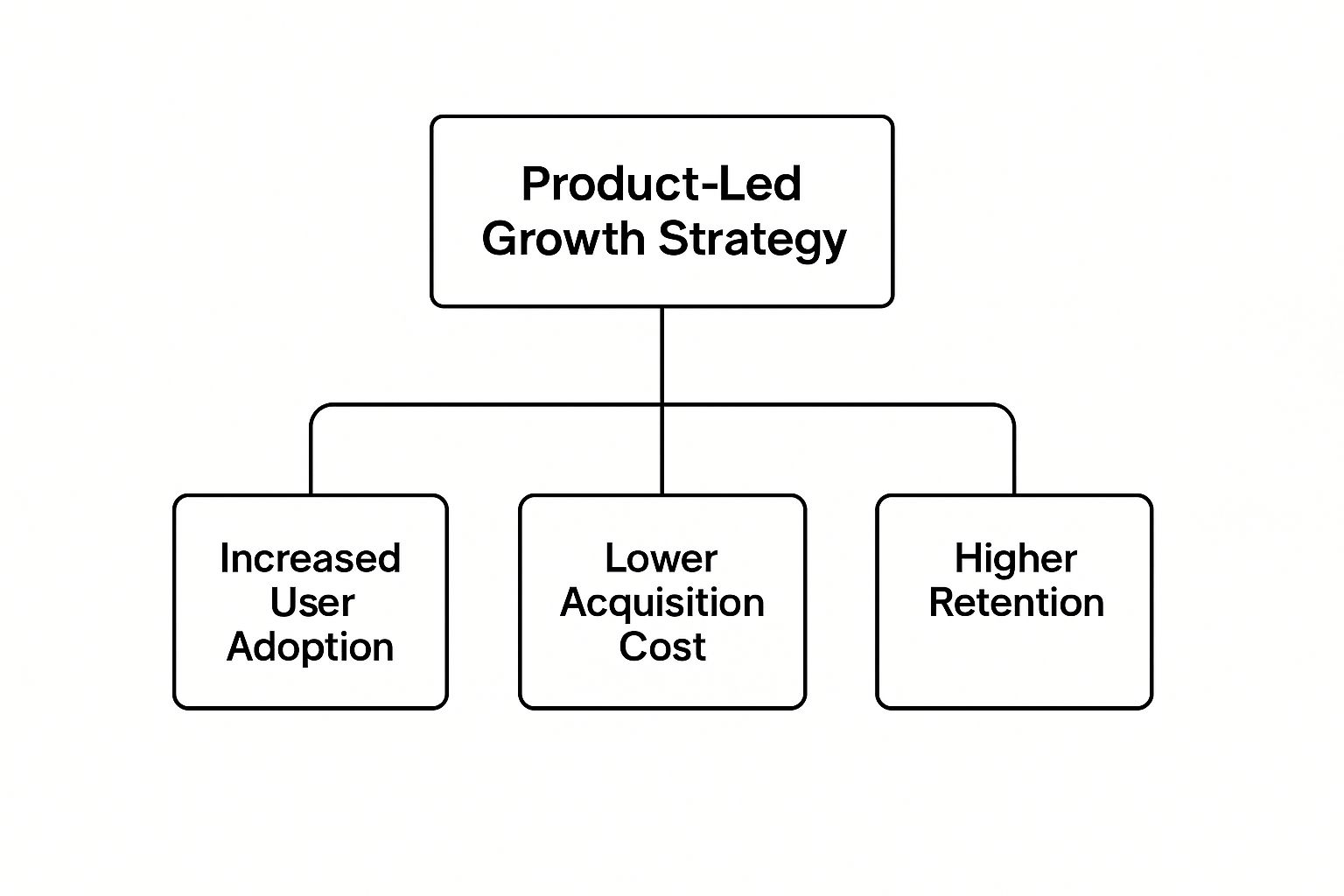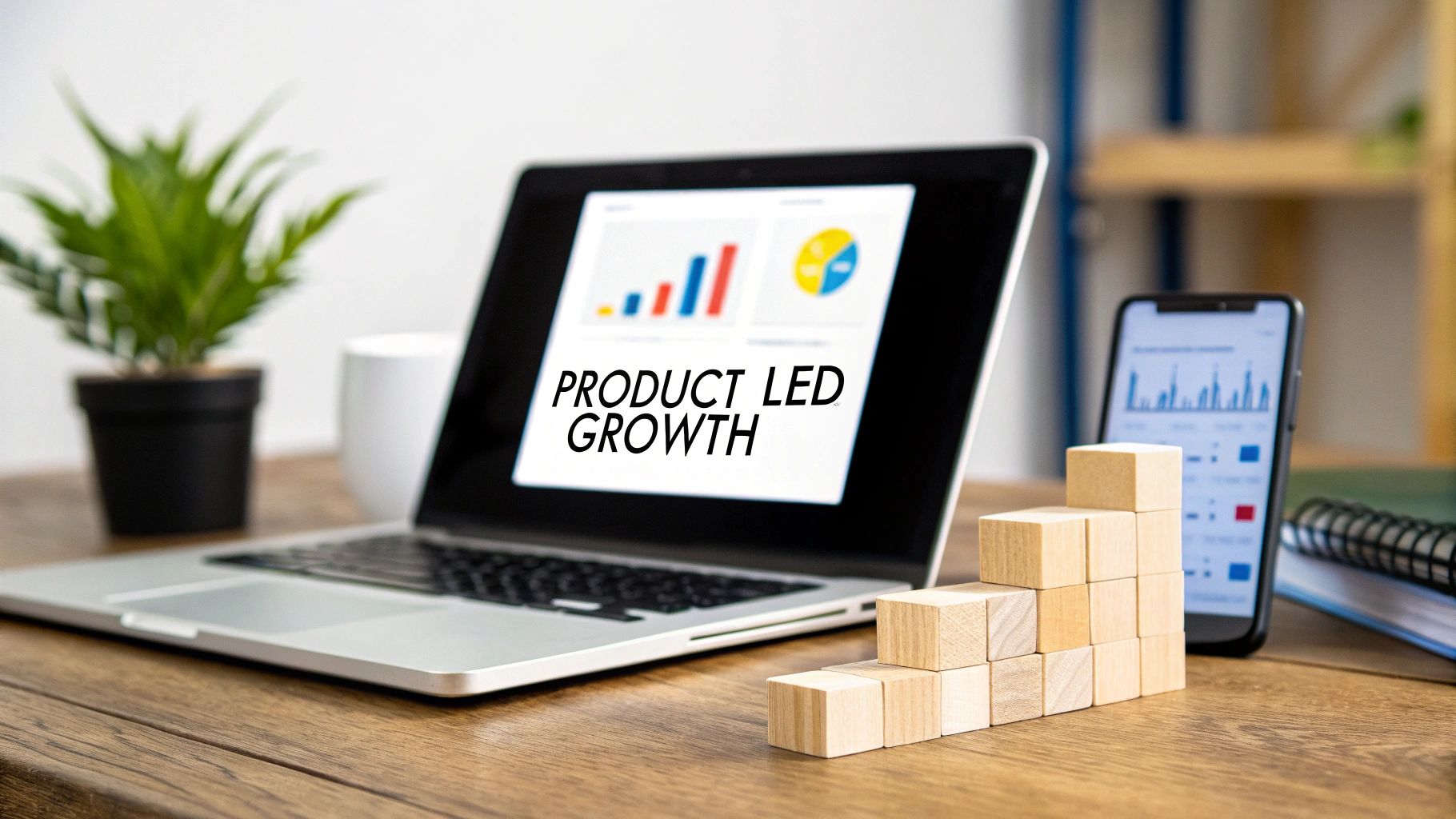Understanding Product Led Growth Strategy Beyond The Hype

This screenshot of Dropbox's interface highlights its clean design and emphasizes how easy it is to use. Notice that prominent "try it free" call to action? That's a key element of a product-led growth (PLG) strategy. Dropbox knows the power of letting the product do the talking.
Instead of bombarding potential customers with sales pitches, they let users experience the value directly. Think of it like this: would you rather hear about a delicious meal or taste it yourself? PLG is all about that first bite.
It's about creating products so good, they practically sell themselves. This approach has been a game-changer, especially for SaaS businesses.
Dropbox, a true PLG pioneer, focused on that magical "aha!" moment when users experienced seamless file syncing. By 2019, they had over 500 million registered users, many of whom started with a free account. This organic growth allowed Dropbox to scale rapidly without a huge sales team. By 2020, they reported annual recurring revenue of roughly $1.66 billion, a testament to PLG's potential. Learn more about what product-led growth is here: https://www.salesmate.io/blog/what-is-product-led-growth/
The Allure of Self-Service
But PLG isn't simply about offering a free trial. It's a whole new way of thinking about the customer journey. It means designing intuitive interfaces, crafting seamless onboarding experiences, and consistently delivering value that keeps users engaged.
This organic adoption, driven by the product itself, sparks a powerful network effect. Happy users naturally become advocates, spreading the word and fueling further growth. This reduces the need for expensive marketing and allows companies to scale more efficiently.
This organic, user-driven growth is what truly sets PLG apart. Now, let's move beyond the buzz and explore the core principles behind making this strategy work.
The Three Foundation Pillars Of PLG Success
Every effective product-led growth strategy depends on three interconnected pillars. These pillars work together, and if you neglect even one, the whole system can suffer. Think of it like a three-legged stool—take away one leg, and the whole thing collapses.
The first pillar is product-market fit. This means building a product that truly resonates with users and solves their problems effectively. It's not about convincing people to use your product; it's about creating something they genuinely want. Think of how intuitive apps like Slack replaced internal emails—they solved a real problem and offered a better experience.
The second pillar is a frictionless user journey. This means smoothly guiding users from initial interest to deep engagement, without any pressure. Successful product-led growth companies carefully map these journeys, optimizing every step for maximum impact. It’s all about making the experience so seamless that users effortlessly upgrade from a free trial to a paid subscription. Calendly's freemium model, combined with its inherent virality, is a great example. It lets potential customers try the product before committing to a paid plan. If you want to learn more, take a look at some product-led growth examples and how they improve the user journey.
The third pillar is viral loops and network effects. This is all about turning your users into your best growth engine. Think about how Figma's collaborative features encourage teams to invite new members, creating a self-sustaining growth cycle. This organic growth reduces the need for traditional marketing, letting the product itself do the talking. For insights into the evolving role of customer support within this model, check out this article on the Future of Customer Support in Product Led Growth SaaS Companies.
The infographic below visually represents how a product-led growth strategy leads to greater user adoption, lower acquisition costs, and improved user retention.

As the infographic shows, these three benefits—increased user adoption, lower acquisition costs, and higher retention—are the direct results of a well-executed product-led growth strategy. They work together to create a powerful engine for sustainable business growth. By focusing on these core pillars, companies can build products that not only attract users, but also keep them engaged and turn them into advocates. This creates a positive feedback loop that fuels continuous growth and strengthens market leadership.
PLG Pillar Comparison: Traditional vs Product-Led Approaches
To further illustrate the differences between traditional sales-led and product-led approaches, let's examine how these pillars translate into core business functions. The table below highlights these key differences and provides the metrics each model prioritizes.
| Business Function | Traditional Sales-Led | Product-Led Approach | Key Metrics |
|---|---|---|---|
| Customer Acquisition | Sales team outreach, advertising, lead generation | Freemium/free trial, virality, in-product onboarding | Customer Acquisition Cost (CAC), Trial-to-Paid Conversion Rate |
| Product Onboarding | Sales demos, training sessions | Self-serve tutorials, interactive guides, in-product prompts | Time to First Value (TTFV), Activation Rate |
| Customer Retention | Customer success managers, account management | Product usage data, personalized in-app communication | Customer Churn Rate, Customer Lifetime Value (CLTV) |
| Expansion | Upselling, cross-selling by sales team | In-product upgrades, feature unlocks, usage-based pricing | Average Revenue Per User (ARPU), Expansion Revenue |
In essence, a product-led approach shifts the focus from sales-driven activities to empowering users to experience the value of the product firsthand. This translates to different priorities in how various business functions operate and how success is measured.
Engineering Your Product's Magic 'Aha Moment'
The "aha moment"—it's that flash of insight, that sudden realization of value that transforms a casual browser into a devoted user. Think about the first time you experienced the seamless collaboration of Figma or the effortless auto-save feature of Google Docs. That's the magic we're talking about, not just understanding a product, but feeling its benefit.
Many companies assume this moment happens naturally. But for companies employing a successful product-led growth strategy, these moments are carefully crafted. They actively design the user journey to deliver that "aha!"—understanding the psychology behind why users find value. Let's explore how you can identify and create these powerful moments in your own product.
Identifying the Aha Moment Through User Research
The journey to uncovering your product's aha moment begins with truly understanding your users. Meaningful user interviews are key. Instead of asking what users think they want, observe how they actually use your product. Focus on open-ended questions like, "What's the biggest hurdle you face in your daily work?" and "How does this product help you overcome it?"

This screenshot showcases Notion's clean interface, highlighting how adaptable it is to various tasks. The clear organization and customization options help users quickly grasp how the platform can meet their specific needs, contributing to a faster "aha moment."
Beyond user interviews, analyzing behavioral data is crucial. Tools like Mixpanel or Amplitude track in-app actions, revealing usage patterns. Look for connections between specific actions and long-term engagement. For example, if users who create a certain number of projects in their first week are more likely to subscribe, that action could be tied to your aha moment. This data-driven approach reveals not only when users "get it" but also why some might not.
Designing for the Aha Moment
Once you've pinpointed your aha moment, design your product to deliver it quickly and reliably. This involves streamlining onboarding, showcasing key features, and offering helpful guidance. If your aha moment hinges on collaboration, for example, make it easy for users to invite team members and experience that value right away. Progressive disclosure is key—introduce features gradually to avoid overwhelming users.
This isn't about trickery; it's about helping users discover real value faster. By creating these moments of realization, you turn casual users into enthusiastic advocates. These engaged users become part of your growth engine, recommending your product and building a thriving community. This organic growth is at the heart of a successful product-led growth strategy.
Building Onboarding That Users Actually Complete
Think about most onboarding experiences you've had. How many felt like being dropped on a deserted island – exciting at first, but quickly turning confusing and overwhelming? Great onboarding, on the other hand, should feel like having a knowledgeable friend guiding you. It's about being informative without being overwhelming, and helpful without being intrusive. Let's explore how to build onboarding that users not only complete, but actually enjoy.
The Psychology of Effective Onboarding
Effective onboarding is built on the principle of progressive disclosure. Imagine teaching someone to drive by explaining every single button, switch, and gauge before they even start the engine. It would be information overload! Software onboarding is no different. Introduce core features gradually, letting users build confidence and mastery at each step before moving on. This allows them to learn by doing, rather than being bombarded with information.
Look at successful product-led growth companies like Slack. Their onboarding focuses on one key action: sending your first message. This quick win provides immediate value and encourages users to explore further. That initial sense of accomplishment lays the foundation for long-term engagement.
Contextual Guidance: The Right Help at the Right Time
Imagine a GPS that only gave directions after you'd already taken a wrong turn. Useless, right? Effective onboarding uses contextual guidance to provide help at the exact moment users need it. This could be through in-app tooltips, interactive tutorials, or even personalized messages triggered by specific user actions. The goal is to anticipate questions and provide answers proactively, creating a smooth and frustration-free experience.
Measuring Onboarding Success: Beyond Completion Rates
Just because users finish your onboarding doesn't mean it's successful. The real question is: what happens next? Are they actively using the core features? Are they achieving their desired outcomes? These are the metrics that truly predict long-term satisfaction and retention. You might find this helpful: SaaS Onboarding Best Practices. Instead of simply tracking completion rates, focus on metrics like Time to First Value (TTFV) and activation rate. These tell you how quickly users experience the core benefit of your product and start performing key actions.
To help you understand how to measure your onboarding effectiveness, let's take a look at some key metrics and benchmarks. The following table outlines the key metrics to track at each onboarding stage, along with benchmarks for good performance and tactics for improvement.
Onboarding Performance Metrics and Benchmarks
| Onboarding Stage | Key Metric | Good Performance | Optimization Tactics |
|---|---|---|---|
| Initial Sign-Up | Completion Rate | >70% | Simplify the sign-up process, minimize required fields, offer social login |
| First Login | Feature Discovery | >50% of key features used | Highlight key features with tooltips or walkthroughs, offer personalized recommendations |
| Initial Use | Time to First Value (TTFV) | < 1 day | Streamline the path to core value, provide clear instructions and examples |
| Ongoing Engagement | Activation Rate | >50% of users perform key actions | Offer targeted in-app messages and guidance based on user behavior |
By tracking these metrics, you can identify areas for improvement and optimize your onboarding flow for better user engagement and retention. Remember, the goal isn't just to get users through onboarding, but to set them up for long-term success with your product.
A/B Testing Your Onboarding for Continuous Improvement
Even a well-designed onboarding process can be improved. A/B testing allows you to experiment with different approaches. Try tweaking the order in which you introduce features, changing the language in your in-app messages, or redesigning your interactive tutorials. By analyzing user behavior and pinpointing where users drop off, you can continually refine the experience. This iterative process helps you understand what truly resonates with your users and keeps your onboarding effective over time.
Smart Personalization In Your PLG Strategy

In today's competitive software world, personalization is essential. It's no longer a nice-to-have, but a must-have. True personalization, however, goes far beyond simply adding a customer's name to an email. Think bigger.
The best product-led growth companies use behavioral intelligence to create experiences that feel tailor-made. They study how users work, what they prefer, and how they interact with the product itself.
Think of how Spotify magically recommends music you'll love through its Discover Weekly playlist. Or how Netflix seems to know exactly what you're in the mood to watch. That's the power of personalization, and it's just as relevant for SaaS products.
Using Behavioral Data to Drive Personalization
Successful PLG companies don't rely on guesswork. They use data. By analyzing user actions, preferences, and in-app behavior, they can offer the most relevant features and content at exactly the right moment.
This isn’t about being intrusive. It’s about being helpful. One effective strategy for building onboarding flows is to highlight the core value proposition, like this B2B startup which saw a 16% conversion rate from sign-ups to demo requests.
For example, imagine a user spends a lot of time exploring your product's project management features. Your product could proactively suggest relevant templates or integrations. This anticipates their needs and speeds up their time-to-value. Personalized onboarding flows guide users to the features that matter most to them, making the initial experience smoother and more engaging.
Predictive Analytics: Anticipating User Needs
Data allows companies to use predictive analytics. This means understanding user needs before they even ask. By recognizing patterns in behavior, you can proactively offer help or suggest relevant features.
This makes users feel valued and understood, leading to higher engagement and better long-term retention. The importance of data and personalization in PLG is only growing.
As AI develops, companies are using predictive analytics to better understand user behavior and personalize their product accordingly. By 2025, PLG companies will rely even more on data-driven decisions, using tools like Mixpanel or Amplitude to track user engagement and refine the product experience. This shift is driven by rising customer expectations; personalized experiences are now the standard, not a bonus. For example, a McKinsey study showed that data-driven companies typically see a 20-30% revenue increase compared to those that aren’t. Learn more here.
Balancing Personalization with Privacy
Of course, this power comes with responsibility. In a post-GDPR world, balancing personalization and privacy is crucial. Transparency is paramount. Users must know what data you collect, how you use it, and what benefits they get in return.
This builds trust and ensures that personalization feels helpful, not invasive. It's about responsibly using data to improve the product experience, not exploiting it. This means choosing carefully which data points you collect and ensuring users have control over their data.
Evolving From PLG To Product-Led Sales
Product-led growth (PLG) is a fantastic way to get those first users on board, especially for SaaS companies. It lets people experience the value of your product directly, leading to natural growth and less reliance on traditional sales. However, as you grow and start aiming for bigger enterprise clients, a completely self-serve model might not cut it. That's where product-led sales steps in.
Bridging the Gap Between Product and Sales
Product-led sales isn't about ditching your PLG principles. It's about realizing that sometimes, a personal touch is needed to close those bigger, more complex deals. Think of it like this: someone might happily use a project management tool on their own, but a large company will probably need help integrating it across different departments.
This combined approach uses the best of both worlds. Companies like Slack, Zoom, and Calendly have successfully blended sales teams into their product-led strategies. They use their products to find product-qualified leads (PQLs) – users who are highly engaged and more likely to become paying customers, particularly at the enterprise level. Sales teams then step in to offer personalized support and help with complicated purchasing decisions.
The move from PLG to product-led sales is a big trend. Companies are going beyond just product development to better integrate sales strategies. According to McKinsey, this change is needed because while PLG is great for early user acquisition, it often needs traditional sales models to seal the deal with enterprise clients. For example, Slack uses sales teams to target larger companies, highlighting the need for a mixed approach. By 2020, Slack had over 1 million organizations using its platform, with many of them being large enterprises.
Identifying Enterprise-Ready Accounts
So, how can you tell if a PQL is ready for a sales conversation? Look for behavioral signals. Some examples include:
- High product usage: Are they constantly using important features?
- Inviting team members: Are they expanding use within their company?
- Reaching usage limits: Are they hitting the ceiling of their current plan?
These signs suggest a strong interest in your product and a possible need for enterprise-level features.
This image shows Slack's interface, emphasizing its teamwork features like channels and direct messaging. The simple design makes it easy for people to connect and share, which is why it's so popular with companies of all sizes. These features are exactly what make Slack attractive to enterprise clients wanting better communication and collaboration tools.
Training Sales Teams for Product-Led Success
Your sales team needs to remember these aren't cold calls. They're talking to users who already understand your product's value. For more on personalized video marketing, see how video can improve your sales approach. The sales conversation should focus on understanding the client's specific needs and showing how your product can meet those needs at scale. This requires a helpful approach, focusing on partnership rather than a hard sell.
Maintaining Your Product-Led DNA
Switching to product-led sales doesn't mean forgetting your PLG roots. It's about adapting your strategy to win bigger deals. By focusing on user experience, constantly improving your product, and giving your sales team solid product knowledge, you can grow smartly and build lasting revenue growth. This hybrid approach lets you keep your product-led focus while also securing deals that a purely self-serve model might miss.
Key Takeaways For Your PLG Journey
Now that we've covered the fundamentals of product-led growth, let's talk about putting these ideas into practice. Remember, it's not about copying what worked for Dropbox or Slack. It's about adapting proven methods to your unique product, your resources, and your goals.
Assessing Your Current Position and Setting Realistic Goals
Product-led growth starts with an honest look in the mirror. What are your strengths? Where do you need to improve? Maybe your users love the product but struggle with onboarding. Or perhaps your free trial conversion rate is low, suggesting you're not showcasing value quickly enough. Pinpoint these areas for improvement and set achievable goals. Don’t try to do everything at once. Focus on the changes that will deliver the biggest impact given your specific circumstances.
Gaining Stakeholder Buy-In and Building Momentum
Shifting towards a product-led approach often requires internal changes. Get key stakeholders on board by clearly explaining the advantages of PLG, highlighting potential gains in metrics like customer acquisition cost (CAC) and customer lifetime value (CLTV). Begin with small, focused experiments to show early wins and generate excitement. This might involve A/B testing different onboarding flows in your product or personalizing in-app messages. Early successes not only prove the value of PLG, but also encourage broader adoption within your team.
Prioritizing Initial Experiments and Measuring Meaningful Progress
Once you have internal support, prioritize experiments that address your main areas for improvement. Aim for quick wins that demonstrate the impact of PLG. If onboarding is a weakness, try experimenting with different welcome messages or interactive tutorials within the product itself. Track your progress diligently, paying close attention to the metrics that truly align with your business objectives. This could be tracking trial-to-paid conversion rates, activation rates, or time-to-first-value (TTFV). Product-Led Growth Metrics can be a useful resource here. By consistently measuring progress, you can showcase the effectiveness of your efforts and fine-tune your PLG strategy as you go.
Embracing the Long-Term Vision and Avoiding Common Pitfalls
Product-led growth is a marathon, not a sprint. It requires a shift in thinking, from sales-led to user-centric, focusing on empowering users and fostering organic growth. Don’t expect miracles overnight. Building a solid PLG foundation takes time and consistent effort. Concentrate on creating a product users truly love, and the growth will follow. This long-term perspective, combined with a willingness to adapt and learn, will set you up for lasting success.
To help you track and analyze your PLG efforts, here’s a handy table summarizing essential metrics:
Introducing the following table, "Essential PLG Metrics and Benchmarks," gives a comprehensive overview of critical PLG metrics including industry benchmarks and calculation methods.
| Metric | Calculation | Good Benchmark | What It Tells You |
|---|---|---|---|
| Trial-to-Paid Conversion | (Paid Users / Total Trial Users) * 100 | 10-20% | Percentage of free trial users converting to paying customers. A key indicator of product value and effective onboarding. |
| Customer Churn Rate | (Churned Customers / Total Customers) * 100 | <5% | Percentage of customers who cancel their subscription. A low churn rate signifies customer satisfaction and retention. |
| Activation Rate | (Activated Users / Total Users) * 100 | Varies | Percentage of users who complete key actions demonstrating product value (e.g., completing a profile, inviting a team member). |
| Time-to-First-Value (TTFV) | Time taken for a user to experience core value | As short as possible | Shows how quickly users realize the benefits of your product. A shorter TTFV is often correlated with higher conversion. |
This table provides a starting point for understanding the key metrics you should track. The benchmarks are general guidelines, and the specific targets for your business may vary depending on your industry, pricing, and product. Focus on consistent improvement in these metrics over time to validate your PLG strategy.
Ready to easily integrate an affiliate program into your SaaS product and accelerate your growth? Refgrow makes it simple to turn your users into your biggest advocates. Embed our affiliate software directly into your application with just a single line of code and unlock the power of referral marketing. Visit Refgrow today and start scaling your growth.

